- 1Center for Scientific Research and Entrepreneurship, Northern Border University, Arar, Saudi Arabia
- 2Department of Mathematics, College of Science, Northern Border University, Arar, Saudi Arabia
- 3Department of Finance and Insurance, College of Business Administration, Northern Border University, Arar, Saudi Arabia
- 4Department of Computer Science, College of Science, Northern Border University, Arar, Saudi Arabia
The stochastic time-fractional Kuramoto–Sivashinsky (STFKS) equation models a wide range of physical phenomena involving spatio-temporal instabilities and noise-driven dynamics. Accurate analytical solutions to this equation are essential for understanding the influence of fractional derivatives and stochasticity in nonlinear systems. This study applies the Tanh–Coth method and He's Semi-Inverse (HSI) method in conjunction with the Truncated M-fractional derivative (TMFD) framework to derive exact solitary wave solutions of the STFKS equation. These approaches are implemented under a traveling wave transformation to reduce the governing partial differential equation to an ordinary differential equation. Exact analytical solutions are obtained for the STFKS equation, and graphical plots are presented to visualize the physical characteristics of the derived wave profiles under varying fractional orders and stochastic conditions. The results confirm that both the Tanh–Coth and HSI methods are effective and reliable for solving the STFKS equation. The graphical analysis reveals the significant impact of fractional parameters and stochastic terms on the solution behavior, demonstrating the practical utility of the proposed methodology in nonlinear stochastic modeling.
1 Introduction
Non-linear stochastic partial differential equations (NSPDEs) are crucial in modeling complex phenomena across various scientific fields. They are essential in describing dynamic processes in physics, fluid dynamics, plasma physics, nonlinear dynamics, and wave propagation, as well as in disciplines such as mathematics, finance, biology, mechanical engineering, chemistry, and genetics [1–6]. Various methodologies have been developed to obtain exact and numerical solutions to NSPDEs. These include the Jacobi elliptic function method, improved fractional sub-equation method, bilinear Bäcklund transform, He's homotopy perturbation method, (G′/G)-expansion method, Bernoulli sub-equation function method, improved Fan's sub-ordinary differential equation method, auxiliary equation methods, and Kudryashov method [7–15]. The Kuramoto–Sivashinsky (KS) equation is one of the NSPDEs due to its non-linear, dissipative, and spatiotemporal dynamics [16]. As a non-linear partial differential equation, it exhibits complex behavior driven by non-linearity, diffusion, and higher-order derivatives. This equation is often used to model phenomena such as flame propagation and pattern formation, highlighting its role in describing systems where spatial x and temporal t non-linear interactions influence variations. The mathematical formulation of the KS equation is as follows:
where function ϕ(x, y) represents variable x in conjunction with the variable t and ν, ρ, η are constants. The time fractional KS equation is given by [17]:
This equation contains the term , which results from using the Truncated M-fractional derivative (TMFD) technique introduced by Sousa et al. [18]. TMFD represents a notable advancement in fractional calculus, with significant applications across various fields like physics, mathematics, finance, biology, chemistry, and engineering. In Equation (2), TMFD is expressed as representing a fractional derivative with respect to t of order α. Additionally, TMFDs are defined as follows: the first order are and fractional derivatives with respect to t and x, respectively, the second-order are and , and the fourth-order is , where these derivatives are applied recursively. In recent years, many models have been formulated in the literature using fractional derivatives [18–23].
The stochastic time fractional KS (STFKS) equation is given as [24]:
This equation, W(t), represents a random variable known as standard Brownian motion (SBM), with σ indicating the noise term in the Itô sense. SBM, introduced by Wiener [25], has been a key element in the development of stochastic process theory. Incorporating TMFD in soliton theory is particularly beneficial because it can precisely describe soliton wave behaviors and offer deeper physical insights. With this in mind, this paper employs the Tanh–Coth and He's Semi-Inverse (HSI) methods to derive traveling wave solutions for Equation (3).
The Tanh–Coth and HSI methods are widely recognized for their utility in constructing traveling wave solutions for various NSPDEs [26–29]. Despite their effectiveness in many contexts, their application to the STFKS equation has remained relatively unexplored, making this research both novel and significant. Recognizing the limitations of existing solution methods for the STFKS equation, the motivation behind this study is to leverage the Tanh–Coth and HSI methods to discover new analytical solutions. The main objective of this study is to explore the use of these methods to find analytical solutions to the STFKS equation and examine the implications of these solutions for understanding the behavior of non-linear systems. These methods promise to expand the repository of exact solutions for the STFKS equation and provide deeper insights into the intricate behaviors of fractional-order non-linear systems. By transforming the STFKS equation into an ordinary differential equation (ODE) using a traveling wave transformation, this paper uncovers a broader spectrum of exact analytical solutions. Graphical representations are also included to illustrate the physical characteristics of these solutions visually, and the impact of varying the fractional order αand noise terms σ is explored. The structure of this paper is as follows: Section 2 covers the TMFD technique, Section 3 presents solutions for the space-time STFKS equation, Section 4 provides graphical representations, and Section 5 concludes the study.
2 Truncated M-fractional derivative
Truncated M-fractional derivative (TMFD), introduced by Sousa et al. [18], extends traditional fractional derivatives by combining fractional-order differentiation with a truncation mechanism. This technique enhances flexibility in modeling systems with non-local interactions and memory effects, improving the representation of phenomena like anomalous diffusion and viscoelasticity. The order of the derivative, denoted by α, interpolates between integer and fractional derivatives, with truncation limiting the derivative's influence in specific regions. Key properties include linearity, a generalized Leibniz rule, and the ability to manage initial and boundary conditions, making it valuable for complex system modeling in various fields. The TMFD of the order α, where 0 < α ≤ 1, for a function ψ:[0, ∞) → ℝ, is defined as:
where for x ∈ ℂ and γ > 0, is the truncated Mittag-Leffler function, given by:
and the Gamma function Γ(γ), defined for γ > 0, is:
Note that if ψ is α-differentiable in some open interval (0, a) and a > 0, and exist. Then we have .
The well-defined TMFD is applied by following specific essential properties. Let α∈(0, 1] and assume that ψ and Ω are α-differentiable functions for all positive values of x, where a and b are constants. Then, the following properties hold:
•
•
• .
• , where c is constant.
• .
These properties have been proven by Sousa and de Oliveira [18] and Vanterler et al. [22].
3 The solutions of Equation (3)
Using two distinct methods, the Tanh-Coth and HSI methods, the STFKS in space-time equation is derived by analyzing the wave equation corresponding to Equation (3). Specifically, the following wave transformation is applied:
In this transformation, ψ is a deterministic real-valued function, and k and c are non-zero constants. By employing the TMFD technique, the traveling wave transformation, and the properties of SBM, the following equations are derived:
By substituting Equations (5)–(9) into Equation (3), the following equation is obtained:
Since W(t) represents Brownian motion, taking the expectation on both sides of Equation (10), where , and integrating with the constant of integration set to zero, the following result is obtained:
3.1 Application of the Tanh-Coth method
This method, outlined in [30, 31], is applied in this study to derive wave solutions for Equation (11). By equating the non-linear term ψ2 with the highest-order derivative ψ”', it is determined that the parameter m = 3. Consequently, the solution can be expressed as follows:
where φ = tanh(ξ) and βj, j = 0, ±1, ±2, ±3 are constants to be determined. By substituting Equation (12) into Equation (11) and grouping terms according to powers of φ, the coefficients of each power are set to zero, resulting in a system of algebraic equations. This system is then solved using MAPLE to find the values of the constants. β−3, β−2, β−1, β0, β1, β2, β−3, c, k, and μ, which leads to the final solutions.
Case 1:
In Case 1, the solution of Equation (3) is given by:
Case 2:
In Case 2, the solution of Equation (3) takes the form:
Case 3:
In Case 3, the solution to Equation (3) is given by:
Case 4:
In Case 4, Equation (3) has the following solution:
Case 5:
In Case 5, the solution of Equation (3) is expressed as:
Case 6:
In Case 6, the solution of Equation (3) is given by:
3.2 Application of the He's Semi-Inverse method
This method, outlined in Wazzan [32], simplifies complex problems by dividing them into manageable components and extends its applications to fractional and stochastic systems, providing insights into memory effects and randomness. It is used to derive wave solutions for Equation (11) through a variational formulation,
The solitary wave solution of Equation (11) is proposed in the following form:
where λ is an unknown constant to be determined. Substituting Equation (20) into Equation (19) yields:
Making J stationary concerning λ results in:
From Equation (22), we obtain:
The solitary solution of Equation (11) is obtained as:
Consequently, the solution of Equation (3) is:
Another proposed form for the solitary wave solution of Equation (11) is given as:
where one must determine the unknown constant ϱ. By following the same procedure as above, we obtain:
Thus, the solution of Equation (3) is:
4 Impact of noise and fractional order on solution behavior
This study provides a comprehensive graphical analysis to examine the effects of variations in the noise term and fractional order on the solution behavior of Equation (3). Using fixed parameter values and , within the domains x∈[0, 6] and t∈[0, 2], the graphical representations of the solutions for Equations (12) and (28) are analyzed. Specifically, for Equation (12), the focus is on the behavior of positive values of βj, c, and k.
4.1 The effect of the noise term
The 3D graphs in Figure 1 illustrate the influence of the noise term σ = 0 on the solutions ϕ1(x, t) (Figure 1a) and ϕ8(x, t) (Figure 1b) under the conditions γ = 0.7 and α = 1. Without noise, Figure 1a shows a singular bright profile with a sharply localized peak, representing phenomena like concentrated energy bursts or solitons in non-linear media. In contrast, Figure 1b displays singular periodic solutions characterized by wave-like oscillations with recurring singularities resembling periodic energy spikes or wave instabilities. These behaviors suggest that in the absence of external disturbances, the system exhibits energy localization and transfer (Figure 1a) or periodic instabilities and resonance phenomena in dynamic systems (Figure 1b).
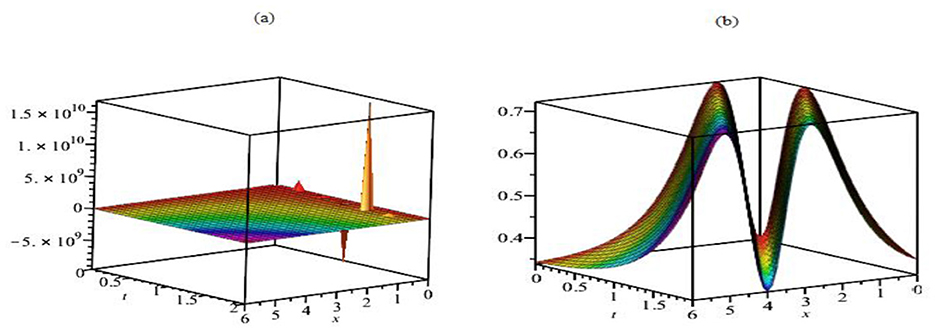
Figure 1. The 3D graphs for the solutions ϕ1(x, t) (a) and ϕ8(x, t) (b), where σ = 0, γ = 0.7and α = 1.
The 3D graphs of Figure 2 illustrate how noise strength affects the system's dynamics. In Figure 2a, at noise strength σ → 1, the solution ϕ1(x, t) appears smooth and planar, indicating that the system's behavior remains stable and uniform across both the x and t domains. In contrast, Figure 2b shows how the solution deviates from this planar structure as the noise strength increases σ > 1. This is evidenced by the emergence of localized spikes and irregularities in ϕ1(x, t), which reflects the influence of stochastic perturbations. The increased noise introduces randomness into the system, disrupting its deterministic behavior and causing the solution to fluctuate. In a physical context, ϕ1(x, t) could represent variables such as concentration, temperature, or displacement, while the noise term σ captures external fluctuations like thermal noise, random forcing, or stochastic environmental interactions.
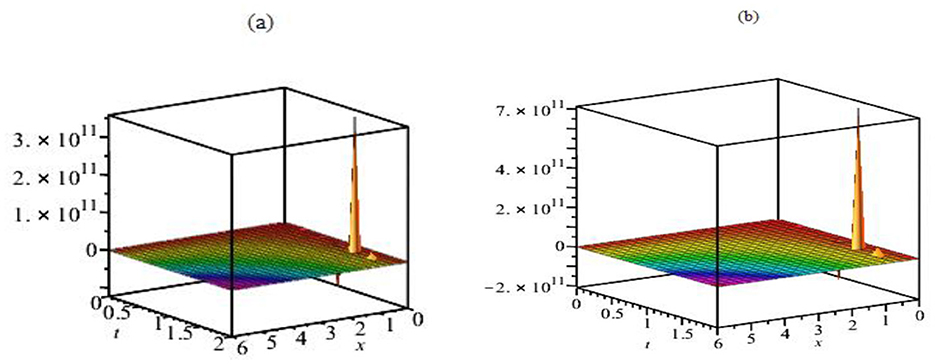
Figure 2. The 3D graphs for the solution ϕ1(x, t), where γ = 0.7 and α = 1 for σ = 1 (a) and σ = 2 (b).
In Figure 3, the 3D graphs for the solution ϕ8(x, t), with γ = 0.7 and α = 1 at two different noise strengths σ = 1 and σ = 2 further illustrate how noise influences the system. The noise strength increases from σ = 1 to σ = 2, and the surface transitions from a relatively smooth, planar structure to a more complex, non-planar one. This shift indicates increased noise strength results in more significant fluctuations and distortions, leading to a more chaotic and turbulent surface. These graphs demonstrate how increasing noise strength exacerbates irregularities and disrupts the smoothness and stability of the solution ϕ8(x, t).
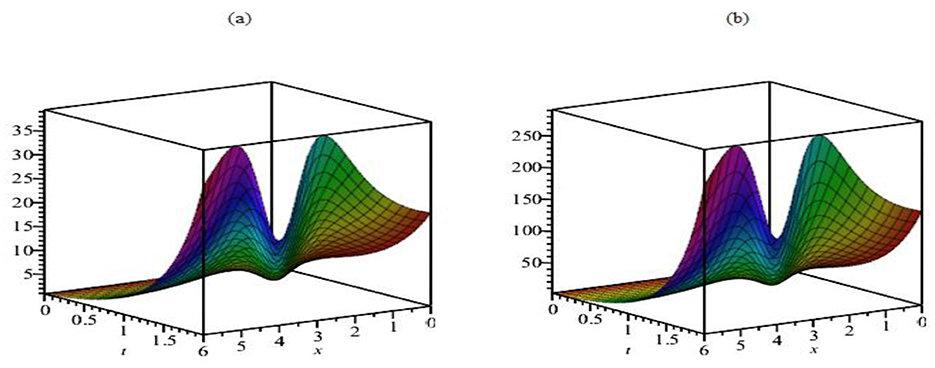
Figure 3. The 3D graphs of the solution ϕ8(x, t), where γ = 0.7 and α = 1 for σ = 1 (a) and σ = 2 (b).
4.2 The effect of the fractional order
A 3D plots of the solutions ϕ1(x, t) is presented in Figures 4a–c, where σ = 0, and the parameter curves of the solution are given as follows: (a) α = 1, γ = 0.7, (b) α = 0.8, γ = 0.7 and (c) α = 0.6, γ = 0.7. The impact of the fractional order on the solution behavior is evident as the surface transitions become less planar. Additionally, Figure 4d shows the 2D plot of the solutions ϕ1(x, t) from Figures 4a–c with the same parameters and x = 1. In the 2D plot, the function value increases with time but decreases with the fractional order, highlighting the sensitivity of the solution to changes in fractional order.
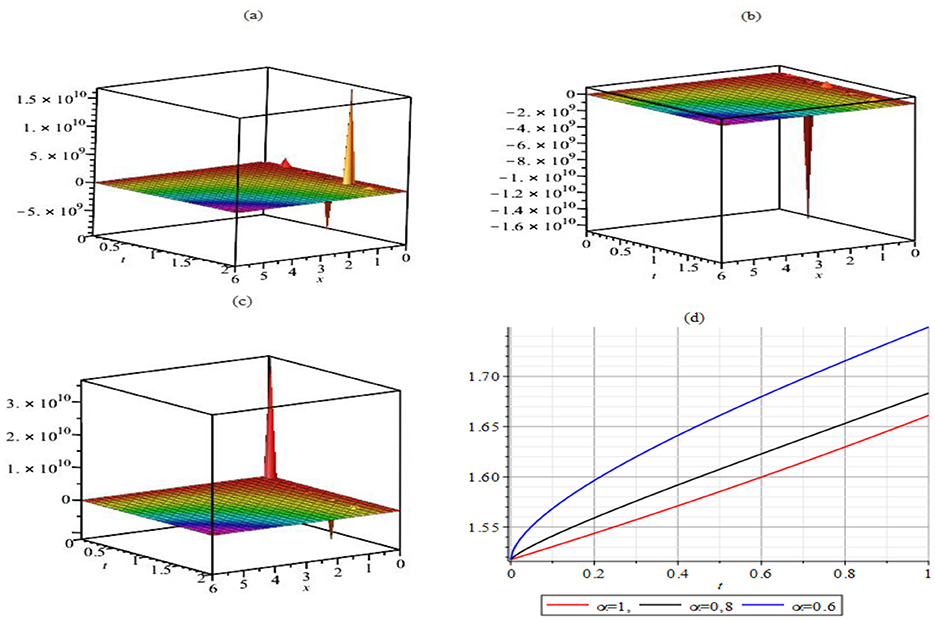
Figure 4. The 3D graphs of the solution ϕ1(x, t), where γ = 0.7 and σ = 0 for α = 1 (a), α = 0.8 (b) α = 0.6 (c) and x = 1 for (d).
Figure 5 illustrates the impact of the fractional order on the solution behavior of ϕ8(x, t). The 3D plots of the solutions are shown in Figures 5a–c for the parameter set with σ = 0. In Figure 5a, where α = 1 and γ = 0.7, the solution displays a standard wave-like behavior. As the fractional order α decreases in Figure 5b with α = 0.8 and γ = 0.7, the wave dynamics become more complex, indicating a more substantial influence of the fractional derivative on the solution's behavior, causing the wave to propagate more slowly and with more significant distortion. In Figure 5c, where α = 0.6 and γ = 0.7, the fractional order further reduces the wave speed and introduces more pronounced deviations in the solution, highlighting the increasing effect of fractional behavior on wave propagation. In Figure 5d, 2D plots of the solutions at x = 1 are provided for the same parameter values, where the wave propagation is observed to occur from left to right. As the fractional order decreases, the wave maintains a fixed amplitude, but its propagation rate slows down, with the solution exhibiting a more spread-out, less sharp profile. This behavior can be interpreted as a result of the fractional order modulating the dispersive properties of the system, slowing down wave propagation, and altering its structure.
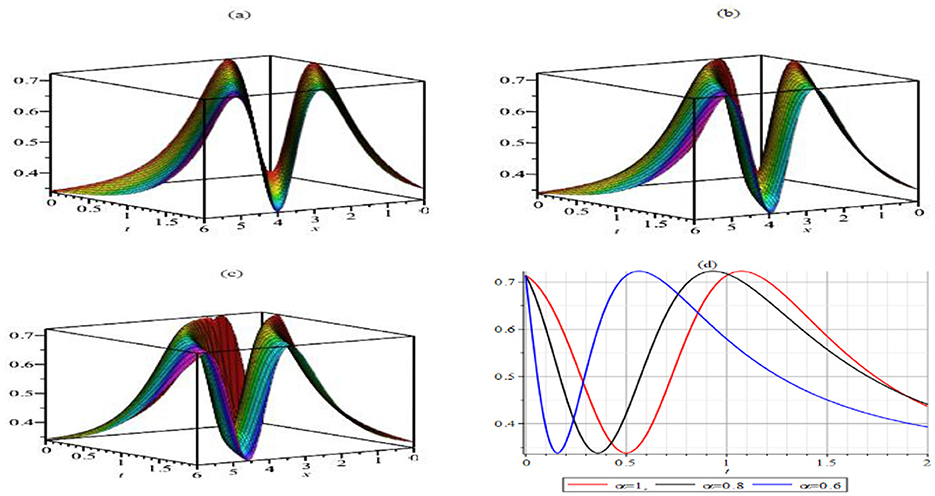
Figure 5. The 3D graphs of the solution ϕ8(x, t), where γ = 0.7 and σ = 0 for α = 1 (a), α = 0.8 (b) α = 0.6 (c) and x = 1 for (d).
5 Conclusion
This study derived analytical solutions for the STFKS equation using a combination of the Tanh-Coth and He's Semi-Inverse methods with the TMFD technique. The solutions include solitons, waveforms, and singular periodic structures, which are critical for interpreting the behaviors described within the STFKS framework. The findings reveal that as the noise term diminishes, solutions become increasingly planar when the fractional order remains constant. Conversely, in the absence of noise, lower fractional orders lead to more intricate wavefront dynamics, transitioning to less planar forms with consistent amplitude propagation. Graphical representations elucidate these phenomena, emphasizing their physical characteristics. MAPLE software facilitated all computations, demonstrating the methods' efficiency. Notably, the derived solutions align with existing results [e.g., [31, 33]] when the noise term is omitted and the fractional order equals 1. This study underscores the sensitivity of fractional-order systems to noise and fractional order variations. Building on these findings, future research could explore the influence of variable fractional orders and noise intensity in dynamic systems governed by the STFKS equation. Extending these methods to multi-dimensional systems and other fractional differential equations could yield more profound insights into complex physical phenomena.
Data availability statement
The original contributions presented in the study are included in the article/supplementary material, further inquiries can be directed to the corresponding author.
Author contributions
AH: Conceptualization, Methodology, Project administration, Software, Supervision, Writing – review & editing. EG: Conceptualization, Methodology, Writing – review & editing. AA: Conceptualization, Methodology, Writing – review & editing. OH: Writing – review & editing. AS: Writing – original draft, Project administration. MS: Writing – original draft, Visualization. FA: Software, Writing – review & editing. ZM: Writing – review & editing, Validation.
Funding
The author(s) declare that financial support was received for the research and/or publication of this article. This research was funded by Deanship of Scientific Research at Northern Border University, grant number NBU-FFR-2025-1266-03.
Acknowledgments
The authors extend their appreciation to the Deanship of Scientific Research at Northern Border University, Arar, KSA for funding this research work through the project number NBU-FFR-2025-1266-03.
Conflict of interest
The authors declare that the research was conducted without any commercial or financial relationships that could be construed as a potential conflict of interest.
Generative AI statement
The author(s) declare that no Gen AI was used in the creation of this manuscript.
Publisher's note
All claims expressed in this article are solely those of the authors and do not necessarily represent those of their affiliated organizations, or those of the publisher, the editors and the reviewers. Any product that may be evaluated in this article, or claim that may be made by its manufacturer, is not guaranteed or endorsed by the publisher.
References
1. Øksendal B. Stochastic Differential Equation: An Introduction with Applications, 6th ed. Berlin/Heidelberg: Springer (2003).
2. Khatoon A, Raheem A, Afreen, A. Approximate solutions for neutral stochastic fractional differential equations. Commun Nonl Sci Numer Simul. (2023) 125:107414. doi: 10.1016/j.cnsns.2023.107414
3. Da Prato G, Tubaro L. Stochastic Partial Differential Equations and Applications. 1st ed. New York: CRC Press (2002). doi: 10.1201/9780203910177
4. Klebaner FC. Introduction to Stochastic Calculus with Applications. 3rd ed. Singapore: World Scientific Publishing Company (2012). doi: 10.1142/p821
5. Allen LJS. An Introduction to Stochastic Processes with Applications to Biology. New York: Chapman and Hall/CRC (2010). doi: 10.1201/b12537
6. Del Moral P, Penev S. Stochastic Processes: From Applications to Theory. New York: Chapman and Hall/CRC (2014).
7. Alquran M, Jarrah A. Jacobi elliptic function solutions for a two-mode KdV equation. J King Saud Univ. (2019) 31:485–9. doi: 10.1016/j.jksus.2017.06.010
8. Sahoo S, Saha Ray S. Improved fractional sub-equation method for (3 + 1)-dimensional generalized fractional KdV–Zakharov–Kuznetsov equations. Comput Mathem Applic. (2015) 70:158–66. doi: 10.1016/j.camwa.2015.05.002
9. Hosseini K, Alizadeh F, Hinçal E, Ilie M, Osman MS. Bilinear Bäcklund transformation, Lax pair, Painlevé integrability, and different wave structures of a 3D generalized KdV equation. Nonlinear Dyn. (2024) 112:18397–411. doi: 10.1007/s11071-024-09944-7
10. Yildirim A, Gulkanat Y. Analytical approach to fractional Zakharov–Kuznetsov equations by he's homotopy perturbation method. Commun Theor Phys. (2010) 53:2. doi: 10.1088/0253-6102/53/6/02
11. Hassaballa A, Salih M, Khamis GSM, Gumma E, Adam AMA, Satty A. Analytical solutions of the space–time fractional Kadomtsev–Petviashvili equation using the (G′/G)-expansion method. Front Appl Math Stat. (2024) 10:1379937. doi: 10.3389/fams.2024.1379937
12. Wang KJ, Shi F, Li S, Xu P. Dynamics of resonant soliton, novel hybrid interaction, complex N-soliton and the abundant wave solutions to the (2 + 1)-dimensional Boussinesq equation. Alex Eng J. (2024) 105:485–95. doi: 10.1016/j.aej.2024.08.015
13. Fendzi-Donfack E, Kenfack-Jiotsa A. Extended Fan's sub-ODE technique and its application to a fractional nonlinear coupled network including multicomponents — LC blocks. Chaos, Solitons Fractals. (2023) 177:114266. doi: 10.1016/j.chaos.2023.114266
14. Fendzi-Donfack E, Tala-Tebue E, Inc M, A. Kenfack-Jiotsa A, Nguenang JP, Nana L. Dynamical behaviours and fractional alphabetical-exotic solitons in a coupled nonlinear electrical transmission lattice including wave obliqueness. Opt Quant Electron. (2023) 55:35. doi: 10.1007/s11082-022-04286-3
15. Fendzi-Donfack E, Nguenang JP, Nana L. On the soliton solutions for an intrinsic fractional discrete nonlinear electrical transmission line. Nonlinear Dyn. (2021) 104:691–704. doi: 10.1007/s11071-021-06300-x
16. Abdel-Hamid B. An exact solution to the Kuramoto–Sivashinsky equation. Phys Lett A. (1999) 263:338–40. doi: 10.1016/S0375-9601(99)00783-5
17. Kulkarni S, Takale K, Gaikwad S. Numerical solution of time fractional Kuramoto-Sivashinsky equation by Adomian decomposition method and applications. Malaya J Matematik. (2020) 8:1078–84. doi: 10.26637/MJM0803/0060
18. Sousa JV, de Oliveira EC. A new truncated M-fractional derivative type unifying some fractional derivative types with classical properties. Int J Anal Appl. (2018) 16:83–96. doi: 10.28924/2291-8639-16-2018-83
19. Kilbas AA, Srivastava MH Trujillo J. Theory and Applications of Fractional Differential Equations. Amsterdam: Elsevier (2006).
20. Khalil R, Al Horani M, Yousef A, Sababheh M. A new definition of fractional derivative', J. Comput Appl Math. (2014) 264:65–70. doi: 10.1016/j.cam.2014.01.002
21. Abdeljawad T. On conformable fractional calculus. J Comput Appl Math. (2015) 279:57–66. doi: 10.1016/j.cam.2014.10.016
22. Salahshour S, Ahmadian A, Abbasbandy S, Baleanu D. (2018). M-fractional derivative under interval uncertainty: Theory, properties and applications. Chaos Soliton Fract. 117:84–93. doi: 10.1016/j.chaos.2018.10.002
23. Atangana A, Goufo EFD. Extension of matched asymptotic method to fractional boundary layers problems. Math Probl Eng. (2014) 1:107535. doi: 10.1155/2014/107535
24. Mohammed WW, Alesemi M, Albosaily S, Iqbal N, El-Morshedy M. The exact solutions of stochastic fractional-space Kuramoto-Sivashinsky equation by using (G′/G)-Expansion method. Mathematics. (2021) 9:2712. doi: 10.3390/math9212712
26. Mohammed WW, Al-Askar FM, Cesarano C, El-Morshedy M. On the dynamics of solitary waves to a (3 + 1)-dimensional stochastic Boiti–Leon–manna–Pempinelli model in incompressible fluid. Mathematics. (2023) 11:2390. doi: 10.3390/math11102390
27. Mohammed WW, Cesarano C, Al-Askar FM, El-Morshedy M. Solitary wave solutions for the stochastic fractional-space KdV in the sense of the M-truncated derivative. Mathematics. (2022) 10:4792. doi: 10.3390/math10244792
28. Haider JA, Alhuthali AMS, Elkotb MA. Exploring novel applications of stochastic differential equations: Unraveling dynamics in plasma physics with the Tanh-Coth method. Results Phys. (2024) 60:107684. doi: 10.1016/j.rinp.2024.107684
29. Akbari M, Taghizadeh N. Applications of He's variational principle method and modification of truncated expansion method to the coupled Klein–Gordon Zakharov equations. Ain Shams Eng J. (2014) 5:979–83. doi: 10.1016/j.asej.2014.03.012
30. Malfliet W. Solitary wave solutions of nonlinear wave equations. Am J Phys. (1992) 60:650–4. doi: 10.1119/1.17120
31. Wazwaz A. Partial Differential Equations and Solitary Waves Theory. Beijing/Berlin: Higher Education Press and Springer-Verlag. (2009). doi: 10.1007/978-3-642-00251-9
32. He JH. Semi-inverse method of establishing generalized variational principles for fluid mechanics with emphasis on turbomachinery aerodynamics. Int J Turbo Jet-Engines. (1997) 14:23–8. doi: 10.1515/TJJ.1997.14.1.23
Keywords: nonlinear partial differential equation, stochastic time fractional Kuramoto-Sivashinsky equation, truncated M-fractional derivative, Tanh–Coth method, He's Semi-Inverse methods
Citation: Hassaballa AA, Gumma EAE, Adam AMA, Hamed OMA, Satty A, Salih M, Abdalla FA and Mohammed ZMS (2025) Application of the Tanh–Coth and HSI methods in deriving exact analytical solutions for the STFKS equation. Front. Appl. Math. Stat. 11:1568757. doi: 10.3389/fams.2025.1568757
Received: 30 January 2025; Accepted: 14 April 2025;
Published: 09 May 2025.
Edited by:
Igor Kondrashuk, University of Bío-Bío, ChileReviewed by:
Waleed Mohamed Abd-Elhameed, Jeddah University, Saudi ArabiaEmmanuel Fendzi Donfack, Université de Yaoundé I, Cameroon
Copyright © 2025 Hassaballa, Gumma, Adam, Hamed, Satty, Salih, Abdalla and Mohammed. This is an open-access article distributed under the terms of the Creative Commons Attribution License (CC BY). The use, distribution or reproduction in other forums is permitted, provided the original author(s) and the copyright owner(s) are credited and that the original publication in this journal is cited, in accordance with accepted academic practice. No use, distribution or reproduction is permitted which does not comply with these terms.
*Correspondence: Elzain A. E. Gumma, ZWx6YWluLmVsemFpbkBnbWFpbC5jb20=
 Abaker A. Hassaballa1,2
Abaker A. Hassaballa1,2 Elzain A. E. Gumma
Elzain A. E. Gumma Ali Satty
Ali Satty Mohyaldein Salih
Mohyaldein Salih Faroug A. Abdalla
Faroug A. Abdalla Zakariya M. S. Mohammed
Zakariya M. S. Mohammed